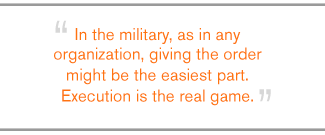You can't blame executives for thinking that leadership must be simpler in the military. In regimented, highly disciplined organizations such as the Army, a leader gives an order, and it's carried out -- no dissension, no complaints, no lollygagging. How simple leadership must be for an Army general. Well, let that dream die. People are people in uniform or not, and a leader's job is to get them on track, not simply to bark orders. So says a reliable source, retired three-star Lieutenant General Russel L. Honoré.

General Honoré has served all over the world in a variety of capacities: in South Korea as commanding general, 2nd Infantry Division; in Washington, D.C., as the vice director for operations, J-3, The Joint Staff; as the deputy commanding general and assistant commandant at the U.S. Army Infantry Center and U.S. Army Infantry School in Fort Benning, Georgia; and as the commander of the Standing Joint Force Headquarters -- Homeland Security, U.S. Northern Command; among many others.
You may remember General Honoré as the man who coordinated the U.S. military's relief efforts after Hurricanes Katrina and Rita ravaged the Gulf Coast. He's also the author of Survival: How a Culture of Preparedness Can Save You and Your Family from Disasters. General Honoré knows quite a lot about bossing people. And he stresses that above all, you shouldn't boss people. A leader's job is strategic: to set people on the right path and "to do the planning and then to motivate the execution," as he says.
As General Honoré relates in this interview, leaders should keep dissenters close because they'll provide a valuable perspective. Leaders should understand the difference between leadership and management so they don't get caught up doing what they're not there to do. And if leaders forget any of this, consider geese. Oddly enough, geese offer a valuable lesson about leadership in the real world.
GMJ: In the military, people do things because they're ordered to -- they can't refuse or negotiate. Yet you've said that human nature and behavior affects the accomplishment of missions. So what role does leadership play when people must do what they're told?
Gen. Honoré: Leadership means forming a team and working toward common objectives that are tied to time, metrics, and resources. The purpose of the commander and the staff is to do the planning and then to motivate the execution. Now, many times you hear leaders say, "This is what we're going to do," but the plans fail if they don't track the execution.
In the military, as in any organization, giving the order might be the easiest part. Execution is the real game. The hierarchy starts with the leadership, which provides vision, wisdom, and motivation. Then there's management. That's turning time, task, and purpose into action. Leadership is working with goals and vision; management is working with objectives. Objectives, as you know, are specific, and they're tied to time, coordination, and resources.
But management is not the same thing as administration; people who do administration work off of checklists. Management works in collaboration with leadership and administration to ensure all the functions of the organization -- from personnel to logistics to finance to human resources -- are tied together to execute that vision and the goals. Administrators are the people who say, "You gotta fill out a form 5988 if you want to get these assets." Administration ensures compliance. The leader's role is to provide the strategic vision for the organization.
GMJ: "Strategic vision" sounds a bit vague.
Gen. Honoré: In the civilian world, the word strategy often means "big things that might happen." In the military world, it means "the purpose of what we're doing, the task to be accomplished, when it will be done, and how and by whom." The purpose is what counts, followed by the tasks and who will do them, how they're going to get done, and when. That's grand strategy that has been documented over hundreds of years of military operation.
Now what continues to change over time is the advantage technology gives us in executing vision. But technology does not replace the core elements: the role of the leader, the role of management, and the role of administrators.
GMJ: It's not unusual for leaders to get caught up in the management part.
Gen. Honoré: Well, that's very easy to do.

GMJ: Why is that?
Gen. Honoré: In a normal organizational construct, people usually grow from management to leadership, and they have a tendency to do what they know best. So if you were formerly a financial guru but now you're the leader, you probably will spend a little bit more time watching finance. And if, when you were in finance, you didn't always like what those guys in research and development did, you take a calculator and you go in there and do a little micromanaging.
In my case, I was always fond of logistics, even though I was an infantry officer. So I would drive all my organizations crazy about logistics because logistics was always the hardest thing to get done. So many times units failed, not because they weren't capable but because they didn't get the gas, the boots, and the bullets on time.
There's an old saying in the Army that if logistics was easy, it'd be called tactics. Tactics comes from a Greek word that means "the arrangement." And what do leaders do? Work the arrangement. They arrange what must be done, and they approve how it will be done. The big thing in industry is always to be the industry lead, because he who sees first, understands first, and he who acts first gets the competitive edge first. That's why the arrangement is so important.
GMJ: What do you do when people buck the arrangement? How do you motivate them to do what they don't want to do?
Gen. Honoré: There's a construct for that. You've got three groups of people in your organization. First, you've got the people who, when you say it, will get it done. Those are the people who want to replace you.
Then you've got the people who are on the team but aren't necessarily motivated to get the task done. Those people are in the middle. You can't run the organization without them, so you take them as they are. They are committed to the company, they're committed to the unit, but they don't work with the enthusiasm of that first group.
And then you have the third group. They're very effective, but they don't seem motivated. They argue with you. What you must decide is, is it OK to have a person from the third group on the team, or should you get rid of him? Members of that third group can be very competent, and many leaders let them go because they aren't jumping up and down every time the boss walks in.
So an art of leadership is to sort those three groups out. You don't have to worry about the ones who want your job. They're clapping every time the boss says something, and they're willing to do whatever it takes to be on the team and be solid key players. Then you've got those who don't cheer, but they get it done. But the third group could be the most productive, because sometimes the least conformist member of that group can say, "Yeah, this is what the boss says, but this is what the organization needs." Some of your best innovation may come from the mavericks.
GMJ: But the last group can cause a lot of trouble.
Gen. Honoré: Yes, but remember that the first group can get you into trouble with "group think." When you're the boss, you might say, "Let's get on with it," which is good for the organization. But then you have a manager from the third group who says, "Yeah, but the boss is wrong." You've got to keep a line of communication open to the leader of that third group because he'll be the one who keeps you out of group think. You can jump on the train awfully quick with an underdeveloped strategy if all you hear is [agreement with] what you just said.
That first group always echoes the leader's words -- if the leader says, "It's Miller time!" the first group all says at once, "It's Miller time!" Group two will nod their heads. Group three says, "No, it's Bud time." All three groups give balance to an organization.
This is a pluralistic view of an organization. Group one is good for accomplishing a mission, but if you don't have people bringing up the negatives, you won't have any perspective.
GMJ: Then how do you gain the right perspective? How do you see things like your customers do?
Gen. Honoré: Look at it this way: In the 1960s and 1970s, executives at the major carmakers never drove a car more than six or seven months. When they drove it to work in Detroit when it was thirty degrees below zero outside, they parked it in the executive garage. Then they'd drive it home and put it in the garage at night. Well, people who bought those cars didn't necessarily have the same perspective. The car executives thought that '65 Impala was a great car, but they never had to start it in the cold. They didn't know how their product really performed. I think American industry has lost perspective about their products.

Instead, leaders must be involved with and live with what they're doing. If you're an airline executive and all you do is ride in business class, you'll have a different perspective than that guy sitting back there in the 34th row. But guess who makes the money for the airline? You might have ten people up there in business class, and meanwhile, 150 people are sitting in the back. You need to understand their perspective.
GMJ: What should leaders do when they realize they've made a mistake? Conversely, how can they tell if they're right?
Gen. Honoré: That's where you must rely on your management team to create the right metrics and to keep a keen eye on what your competitors are doing. In the Army, we used to say, "Are we getting the effect we want against the enemy?" In the business world, the saying is "Are we getting the effects from our energy here?" If you're not measuring your results, then you could lose opportunities. People who are very successful will turn problems into opportunities.
Now, assuming you have earned a position of leadership and that it hasn't been granted to you, you will have learned the art of listening to bad news and diverse opinions. Good leaders understand there will be people who will be open and honest with them. Those people may not be right, but they'll bring a different perspective.
GMJ: How do you create an environment that encourages people to be honest with you?
Gen. Honoré: When I'm talking to young officers about leadership, I use the analogy of watching geese.
GMJ: Geese?
Gen. Honoré: Yeah, geese. They say, "General, what in the hell is that?" I ask them if they've ever noticed that when geese fly, they fly in a V formation. Why do you reckon they do that? It's because they get more flying power from flying in the draft of the lead goose. Geese have learned that the lead goose's job is to go as fast as he can, so the geese in the back all quack as loud as they can to tell the lead goose to go faster.
The other thing you'll find is that when the lead goose gets tired, he'll drop back, and another goose will take charge. And the other geese are still quacking to encourage the new leader to go faster! Faster! Faster!
So if you're the CEO, listen to the crowd behind you. That's the power of getting everybody to go the same direction simultaneously.
-- Interviewed by Jennifer Robison